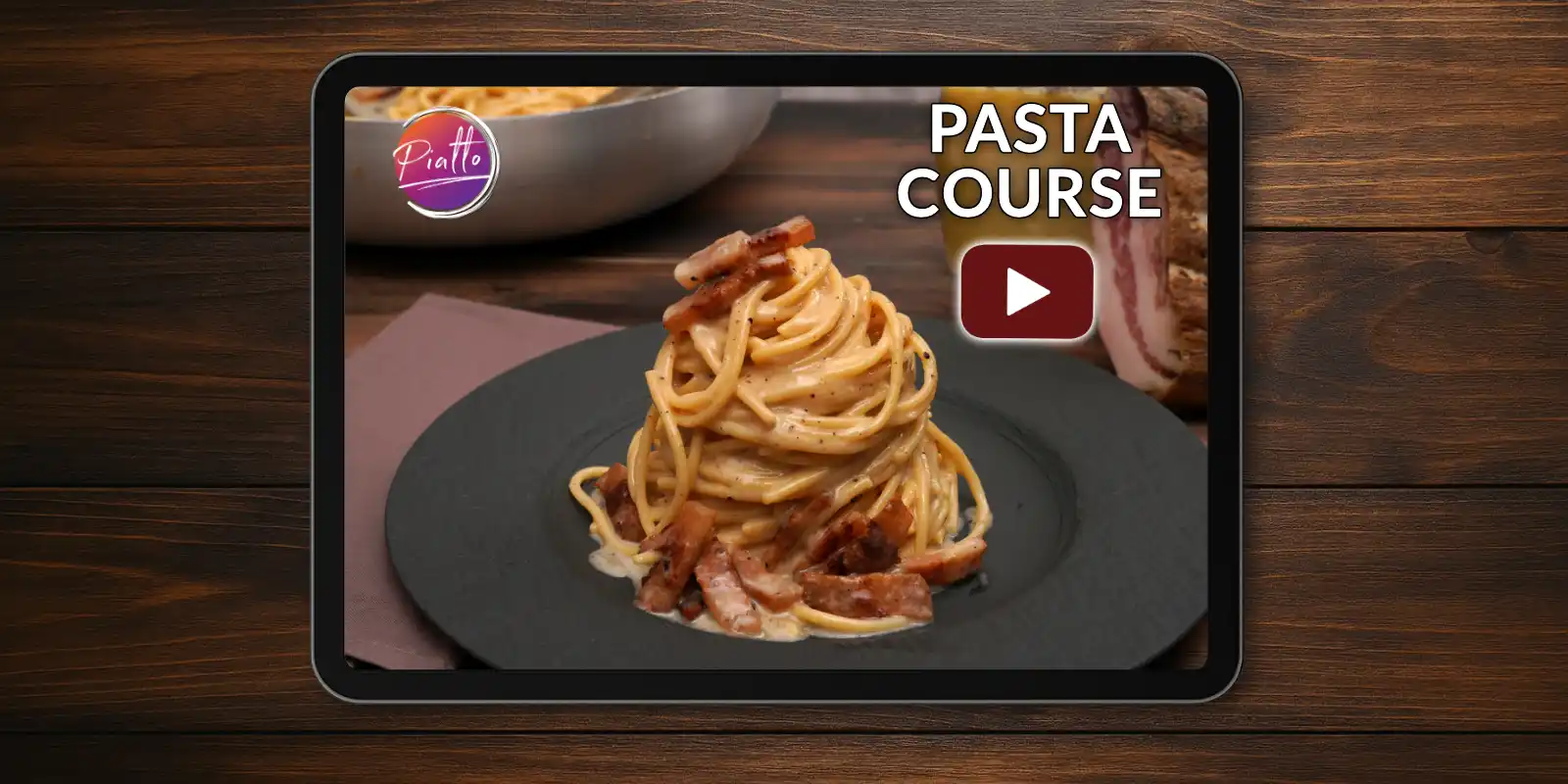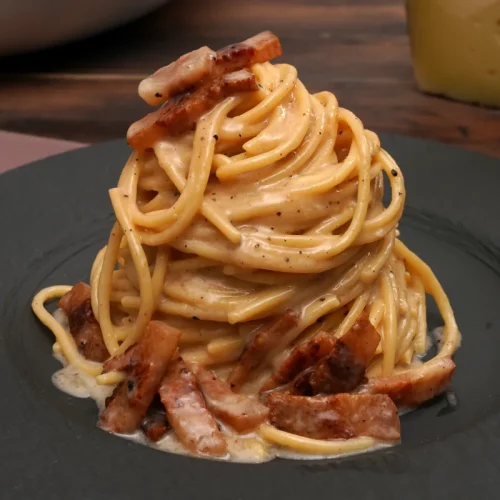Welcome to your free Gricia Pasta Course! This iconic Roman dish is one of the four pillars of Roman Pasta —along with Carbonara, Cacio e Pepe and Amatriciana. In this lesson, we’ll walk you through a traditional method, show you common mistakes to avoid, and explain how to make this famous Italian dish that is increasingly popular around the world. Traditional pasta choices include spaghetti and tonnarelli (Rome’s version of the fresh spaghetti alla chitarra).
This course is part of our series of Free Online Italian Cooking Classes for Pasta, where we teach you to cook pasta like Italians do—from dough to dishes.
Video Class Overview
This lesson is filmed in stunning 4K for visual clarity, with subtitles available in English, French, Spanish, German, and other languages.
Each class is structured to walk you through the techniques used by Italian cooks—so you can see what matters (and what doesn’t) when making pasta the traditional way.
Ingredients and How to Make Gricia Pasta
The full ingredient list and step-by-step instructions are below. We’ve formatted the recipe for easy saving or printing. Be sure to watch the video first—it covers essential technique tips!
We use the most traditional measurements and techniques, so you can recreate this recipe exactly as it would be made in Italy—no shortcuts, no substitutions unless noted.
Gricia Pasta Course: Master a Roman Classic
Ingredients
- 1 tbsp black pepper preferably freshly ground (medium coarse)
- 6 oz pecorino romano cheese semi-aged
- 6 oz guanciale or pancetta
- ½ cup white wine optional to deglaze the pan
- 11 oz spaghetti or tonnarelli
Instructions
Toast the Pepper
- Briefly toast black pepper in a dry pan over low heat—just until you start to smell it. This shouldn’t take longer than a minute. Transfer the pepper to another container and set it aside.
- For the best flavor, freshly grind the pepper using a medium-coarse setting. Medium coarse pepper is easier to toast without over-toasting—and creating pepper gas!
Fry the Guanciale
- Cut the guanciale into thick slices, then into 1/2 inch strips.
- Fry the guanciale in a dry pan over medium-low heat until the fat turns translucent. Then raise the heat a bit to crisp up the outside of the pieces. As the guanciale fries…
Partially Cook the Pasta
- Add the pasta to boiling water and cook it for 3/4 of the cook time recommended for ‘al dente’ pasta in the package instructions.
De-Glaze the Pan
- When the guanciale is fried to your liking, add the white wine to de-glaze the pan. This will give the dish an extra boost of flavor, and serve to pull all of the delicious guanciale grease off the bottom of the pan and into our final sauce
Finish Cooking the Pasta
- Add the partially cooked pasta (drained) to the skillet with the guanciale. Add a few ladles of the hot pasta water as well—and save the pasta water as we will still need it!
- Add the black pepper to the cooking pasta. Finish cooking the pasta in the pan for the rest of the cooking time. Add a ladle of water as needed to make sure the pasta has enough to finish cooking. In the meantime…
Make the Cheese Sauce
- To the finely grated pecorino cheese, slowly drizzle in one ladle of hot pasta water—stirring continuously! Mix until you’ve created a smooth, creamy paste.
Finish the Pasta
- When the pasta is cooked, remove it from the heat. Add the cheese paste to the hot pasta and mix thoroughly using a pair of tongs. This is called the ‘mantecatura’ in Italian. Serve immediately and buon appetito!
Video
Equipment and Tools
You don’t need a professional kitchen to make great pasta—but the right tools can make it easier. For this recipe, we recommend:
- Mortar and pestle – for freshly grinding the black pepper.
- Cheese grating tool – for finely grating the Pecorino cheese. We recommend using the fine grater setting on a food processor or Vitamix. For sauces like Cacio e Pepe or Carbonara, we also suggest passing the finely grated Pecorino through a fine sieve to achieve a powdery consistency.
Video Class Overview
Is This Gricia Pasta Recipe Traditional?
Yes—this is one way that Romans in Italy make Gricia pasta. Variations? Deglaze the pan after cooking the guanciale with hot pasta water instead of wine. Some Romans also skip the Cacio e Pepe style sauce, and instead stir in the dry grated pecorino to the finished pasta off the heat.
Unlike some recipes (such as Amatriciana), Pasta alla Gricia has not been codified by any official Italian authority such as a regional Italian ‘Chamber of Commerce’ or similar. Nonetheless, we’ve taken great pains to ensure that the Gricia Pasta recipe we are sharing with you does align with what is considered traditional for this dish in Italy today. Like many Italian recipes, there are variations within the tradition, but within an accepted list of ingredients.
Pro Tips for Making Cacio e Pepe
Guanciale is More Traditional
Guanciale (cured pork cheek) is more traditional than pancetta (cured pork belly) for this dish. They do have different flavors and textures so use guanciale whenever possible.
Use Less Water to Cook the Pasta
To boost the starch content of the water you’ll use in the sauce, cook your pasta in half the usual amount of water. Less water means a higher starch concentration, which is essential for creating a stable emulsion with the Pecorino cheese.
Then, finish cooking the pasta in a skillet with the deglazed guanciale drippings and a few ladles of the starchy pasta water. This not only intensifies flavor, but also sets up the perfect conditions for mantecatura—the creamy final mix.
Use high-quality, bronze-die cut pasta
This dish relies on the sauce clinging to the pasta and generating enough starch in the pasta water—so the pasta surface matters. Bronze-die cut pasta has a rougher texture that holds onto the sauce better than smooth, industrially extruded pasta. It’s a small detail that makes a big difference in the final result.
See our full article on Best Pasta Brands in Italy to learn more.
Finely grate the Pecorino cheese into a powder
Use semi-aged Pecorino and grate it as finely as possible to ensure a smooth, lump-free sauce. You can start with a fine grater or food processor, but for best results, pass the grated cheese through a fine sieve to get a powder-like consistency.
Make a Pecorino paste—not a sauce
Add just enough hot, starchy pasta water to the cheese to create a thick paste. This will emulsify properly during the final mixing step.
Mantecatura off the heat
Combine the Pecorino paste and pasta off the heat, stirring vigorously to coat each strand. The residual heat and starch will help form that glossy, creamy sauce Romans love.
If you’re using a pan that retains heat well (like stainless steel or carbon steel), let it sit off the heat for about 30 seconds before adding the Pecorino paste. It’s important to stay under 60°C (140°F) to prevent the cheese from coagulating. No thermometer? The 30-second rule usually works.
Common Mistakes to Avoid
Using Bacon, Not Guanciale (or Pancetta)
Bacon (like American bacon) is a product that can be made from various meat cuts and prepared different ways (for instance smoked). Guanciale (cured pork cheek) and pancetta (cured pork belly) are the products used in traditional Italian cooking (not bacon). In most Roman pasta recipes, guanciale is most traditional though occasionally pancetta may be used even by professionals.
Clumpy, gooey cheese sauce
Despite its simplicity, Gricia Pasta is easy to mess up. Common mistakes include:
- Using cheese that isn’t finely grated
- Using fully aged Pecorino that doesn’t melt easily
- Adding too much water to the cheese and making a “sauce” instead of a “paste”
- Leaving too much liquid in the skillet when mantecatura begins—only a couple of spoonfuls should remain
- Adding the cheese paste to a pan that’s too hot or still on the heat
The key is gentle heat, proper technique, and high-quality ingredients. When in doubt, slow down and follow the timing and texture cues shown in the video.
Learn more about terms like mantecatura in our guide: Essential Italian Culinary Terms and Techniques

